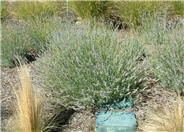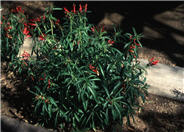
Common name:Grosso Long Stemmed Lavender
Botanical name:Lavandula X intermedia 'Grosso'
Long Stemmed Lavender has beautiful violet colored plumes in the summer. It is very drought tolerant and is a great plant to create that Mediterranean effect.

Common name:Moss Verbena
Botanical name:Verbena tenuisecta
This South American native produces clusters of rosy-purple flowers that bloom from March through September on long, creeping stems. It serves as a good ground cover in poor, sandy soils with either full or filtered sun. -Holland WIldflower Farm

Common name:Climbing Rose
Botanical name:Rosa Climbing varieties
With its dark green foliage and fragrant flowers with full and double blooms, this upright shrub is generally grown as a vine or pillar rose. Climbing varieties come in many colors.

Common name:Red Mexican Lobelia
Botanical name:Lobelia laxiflora
This Lobelia is a very showy, shrub-like perennial, growing to 2'-4' tall. It spreads by underground rhizomes. It has bright, tubular, orange-red summer flowers with yellow orange throats. It can tolerate low water conditions. Hummingbirds love this Lobelia. It thrives in wet soil but does not require it. This is the most tolerant of Lobelias for full sun sites.

Common name:Chinese Wisteria
Botanical name:Wisteria sinensis
While the sinensis is similar to the floribunda, it bears more rounded, full clusters of strongly fragrant flowers which open more or less, all at once. There are usually 13-15 leaflets per leaf, and they require full sun and average to little watering. It comes in many colors in the blues, whites and purples.-Monterey Bay Nursery
| Designer: | Rose Rimmed Fence |
Photographer: GardenSoft |
Soils and Compost:
Incorporate compost 6" into your soil to retain water, reduce compaction, feed earthworms, and provide valuable nutrients to your plants.
Water Saving Tip:
Replace turf with groundcovers, trees, and shrubs. If you have areas where no one uses the grass, patches that do not grow well, or a turf area too small to water without runoff, consider replacing the turf with water-efficient landscaping.
Integrated Pest Management:
Remove irrigation water and fertilizer from areas where you don't want weeds to grow.

